High-Temperature Phase Transformations in Al-Li-Cu-Mg-Zr-Sc Alloy Studied via In Situ Electron Microscopy
Abstract
1. Introduction
2. Materials and Methods
3. Results
3.1. As-Cast Structures
3.2. In Situ Annealing
4. Discussion
5. Conclusions
- ♦
- A high solidification rate during twin-roll casting impacts the size of the eutectic cells. Their average diameter is in the range of several micrometers. The mold-cast material exhibits a larger cell size by one order of magnitude.
- ♦
- The primary phase particles situated at the cell boundaries were identified by ACOM-TEM and EDX analyses as θ-(Al2Cu), T1-(Al2CuLi), S-(Al2CuMg), and Al7Cu2Fe.
- ♦
- The Al7Cu2Fe phase cannot be dissolved during the homogenization annealing. Only indistinctive morphological changes and ripening occur at temperatures above 500 °C.
- ♦
- The remaining primary phase particles dissolve in both materials after 20 min holding time at temperatures close to 550 °C. The duration of this annealing is sufficient to distribute the main alloying elements homogeneously in the original eutectic cells in the TRC material. A couple of tens of hours of homogenization times would be necessary to receive the same homogeneous distribution in the MC material.
- ♦
- The observed processes are in good agreement with recent diffusion models.
Author Contributions
Funding
Institutional Review Board Statement
Data Availability Statement
Acknowledgments
Conflicts of Interest
References
- Prasad, N.; Gokhale, A.; Rao, P. Mechanical behavior of aluminium-lithium alloys. Mat. Sci. Eng. 2003, 28, 209–246. [Google Scholar] [CrossRef]
- Starke, E.A.; Staley, J.T. Application of modern aluminum alloys to aircraft. Prog. Aerosp. Sci. 1996, 32, 131–172. [Google Scholar] [CrossRef]
- Rioja, R.J.; Liu, J. The Evolution of Al-Li Base Products for Aerospace and Space Applications. Metall. Mater. Trans. A 2012, 43, 3325–3337. [Google Scholar] [CrossRef]
- Flower, H.; Gregson, P. Solid state phase transformations in aluminium alloys containing lithium. Mater. Sci. Technol. 1987, 3, 81–90. [Google Scholar] [CrossRef]
- Venkateswara Rao, K.T.; Ritchie, R.O. Fatigue of Aluminum-Lithium Alloys. Int. Mater. Rev. 1992, 37, 153–185. [Google Scholar] [CrossRef]
- Meetsma, A.; Deboer, J.L.; VanSmaalen, S. Refinement of the crystal structure of tetragonal Al2Cu. J. Solid State Chem. 1989, 83, 370–372. [Google Scholar] [CrossRef]
- Noble, B.; Thompson, G.E. T1 (Al2CuLi) Precipitation in Aluminium–Copper–Lithium Alloys. Met. Sci. J. 1972, 6, 167–174. [Google Scholar] [CrossRef]
- Wang, S.C.; Starink, M.J. Precipitates and intermetallic phases in precipitation hardening Al–Cu–Mg–(Li) based alloys. Int. Mater. Rev. 2005, 50, 193–215. [Google Scholar] [CrossRef]
- Heying, B.; Hoffmann, R.-D.; Pottgen, R. Structure Refinement of the S-Phase Precipitate MgCuAl2. Z. Naturschoft. 2005, 60, 491–494. [Google Scholar] [CrossRef]
- Tolley, A.; Radmilovic, V.; Dahmen, U. Segregation in Al3(Sc,Zr) precipitates in Al–Sc–Zr alloys. Scr. Mater. 2005, 52, 621–625. [Google Scholar] [CrossRef]
- Yu, C.; Yin, D.; Zheng, F.; Yu, X. Effects of solution treatment on mechanical properties and microstructures of Al-Li-Cu-Mg-Ag alloy. J. Cent. South Univ. 2013, 20, 2083–2089. [Google Scholar] [CrossRef]
- Huang, H.; Xiong, W.; Jiang, Z.; Zhang, J. A Quasi In-Situ Study on the Microstructural Evolution of 2195 Al-Cu-Li Alloy during Homogenization. Materials 2022, 15, 6573. [Google Scholar] [CrossRef] [PubMed]
- Tang, Y.; Xiao, D.; Huang, L.; You, R.; Zhao, X.; Lin, N.; Ma, Y.; Liu, W. Effect of Minor Sc Addition on the Microstructure Evolution of Al–Cu–Li–Mg Alloy During Homogenization with Different Cooling Modes. Met. Mater. Int. 2022, 28, 2422–2433. [Google Scholar] [CrossRef]
- Yang, S.; Jian, S.; Xiaodong, Y.; Xiwu, L.; Fei, Z.; Baoging, S. Homogenization Treatment Parameter Optimization and Microstructural Evolution of Al-Cu-Li Alloy. Rare Met. Mater. Eng. 2017, 46, 28–34. [Google Scholar] [CrossRef]
- Suresh, M.; Sharma, A.; More, A.M.; Nayan, N.; Suwas, S. Effect of Scandium addition on evolution of microstructure, texture and mechanical properties of thermo-mechanically processed Al-Li alloy AA2195. J. Alloys Compd. 2018, 740, 364–374. [Google Scholar] [CrossRef]
- Li, H.Z.; Ou, Y.J.; Liao, H.J.; Liang, X.P.; Jiang, J. Microstructural Evolution of High Purity Al-Cu-Mg Alloy during Homogenization. Mater. Sci. Forum 2014, 788, 208–214. [Google Scholar] [CrossRef]
- Gazizov, M.; Teleshov, V.; Zakharov, V.; Kaibyshev, R. Solidification behaviour and the effects of homogenisation on the structure of an Al–Cu–Mg–Ag–Sc alloy. J. Alloys Compd. 2011, 509, 9497–9507. [Google Scholar] [CrossRef]
- Nayan, N.; Narayana Murty, S.V.S.; Jha, A.K.; Pant, B.; Sharma, S.C.; George, K.M.; Sastry, G.V.S. Processing and characterization of Al–Cu–Li alloy AA2195 undergoing scale up production through the vacuum induction melting technique. Mat. Sci. Eng. A 2013, 576, 21–28. [Google Scholar] [CrossRef]
- Fink, D.; Hnatowicz, V.; Kvitek, J.; Havranek, V.; Zhou, J.T. External oxidation of aluminium-lithium alloys. Surf. Coat. Technol. 1992, 51, 57–64. [Google Scholar] [CrossRef]
- Xu, P.; Jiang, F.; Tang, Z.; Yan, N.; Jiang, J.; Xu, X.; Peng, Y. Coarsening of Al3Sc precipitates in Al-Mg-Sc alloys. J. Alloys Compd. 2019, 781, 209–215. [Google Scholar] [CrossRef]
- Royset, J.; Ryum, N. Scandium in aluminium alloys. Int. Mater. Rev. 2013, 50, 19–44. [Google Scholar] [CrossRef]
- Clouet, E.; Lae, L.; Epicier, T.; Lefebvre, W.; Nastar, M.; Deschamps, A. Complex precipitation pathways in multicomponent alloys. Nat. Mater. 2006, 5, 482–488. [Google Scholar] [CrossRef] [PubMed]
- Wang, Y.; Xiong, B.; Li, Z.; Zhang, Y.; Teng, H. Precipitation Behavior of Al3(Sc,Zr) Particles in High-Alloyed Al–Zn–Mg–Cu–Zr–Sc Alloy during Homogenization. Arab. J. Sci. Eng. 2021, 46, 6027–6037. [Google Scholar] [CrossRef]
- Fuller, C.B.; Murray, J.L.; Seidman, D.N. Temporal evolution of the nanostructure of Al(Sc,Zr) alloys: Part I—Chemical compositions of Al3(Sc1−xZrx) precipitates. Acta Mater. 2005, 53, 5401–5413. [Google Scholar] [CrossRef]
- DePottey, A.; Jiang, L.; Dorin, T.; Wood, T.; Langan, T.; Sanders, P. Effect of Cooling Rate on W-Phase Formation in Al-Cu-Sc Alloys. In Proceedings of the TMS Annual Meeting and Exhibition Light Metals 2023, San Diego, CA, USA, 19–23 March 2023. [Google Scholar] [CrossRef]
- Li, S.; Jiang, T.; Wang, J.; Chen, L.; Wei, B.; Li, Y.; Xu, G.; Wang, Z. Effects of different external fields on the microstructure and mechanical properties of novel Al-Cu-Li alloy during twin-roll casting. Mat. Sci. Eng. A 2019, 757, 14–22. [Google Scholar] [CrossRef]
- Li, S.; Wei, B.; Yu, C.; Li, Y.; Xu, G.; Li, Y. Evolution of microstructure and properties during homogenization of the novel Al–Li alloy fabricated by electromagnetic oscillation twin-roll casting. J. Mater. Res. Tech. 2020, 9, 3304–3317. [Google Scholar] [CrossRef]
- Grydin, O.; Stolbchenko, M.; Schaper, M.; Belejova, S.; Kralik, R.; Bajtosova, L.; Krivska, B.; Hajek, M.; Cieslar, M. New Twin-Roll Cast Al-Li Based Alloys for High-Strength Applications. Metals 2020, 10, 987. [Google Scholar] [CrossRef]
- Wang, Y.; Wu, G.; Zhang, L.; Guo, Y.; Wang, C.; Li, L.; Xiong, X. Microstructure evolution and mechanical properties of a cast and heat-treated Al–Li–Cu–Mg alloy: Effect of cooling rate during casting. Mat. Sci. Eng. A 2023, 880, 145366. [Google Scholar] [CrossRef]
- MacRae, C.M.; Hughes, E.A.; Laird, J.S.; Glenn, A.M.; Wilson, N.C.; Torpy, A.; Gibson, M.A.; Zhou, X.; Birbilis, N.; Thompson, G.E. An Examination of the Composition and Microstructure of Coarse Intermetallic Particles in AA2099-T8, Including Li Detection. Microsc. Microanal. 2018, 24, 325–341. [Google Scholar] [CrossRef]
- Slamova, M.; Karlik, M.; Rabaut, F.; Slama, P.; Veron, M. Differences in microstructure and texture of Al–Mg sheets produced by twin-roll continuous casting and by direct-chill casting. Mater. Charact. 2002, 49, 231–240. [Google Scholar] [CrossRef]
- Bajtosova, L.; Grydin, O.; Stolbchenko, M.; Schaper, M.; Krivska, B.; Kralik, R.; Slapakova, M.; Cieslar, M. Phase identification in twin-roll cast Al-Li alloys. In Proceedings of the 31st International Conference on Metallurgy and Materials, METAL 2022, Brno, Czech Republic, 18–19 May 2022. [Google Scholar]
- Kim, J.-H.; Yeun, J.-H.; Chun, H.-J.; Lee, R.-J.; Too, J.-T.; Yoon, J.-H.; Lee, H.-S. Effect of precipitates on mechanical properties of AA2195. J. Alloys Compd. 2016, 669, 187–198. [Google Scholar] [CrossRef]
- Jin, Y.; Yu, H. Enhanced formability and hardness of AA2195-T6 during electromagnetic forming. J. Alloys Compd. 2022, 890, 161891. [Google Scholar] [CrossRef]
- Sahoo, S.; Ghosh, S. Microstructure evolution of eutectic Al–Cu strips by high-speed twin-roll strip casting process. Appl. Phys. A Mater. 2015, 121, 45–50. [Google Scholar] [CrossRef]
- Zhang, Y.; Wang, J.; Chen, D.; Wang, B.; Zhang, C.; Wang, Z. Effects of cooling rates on microporosity in DC casting Al-Li alloy. China Foundry 2022, 19, 177–190. [Google Scholar] [CrossRef]
- Zhang, F.; Shen, J.; Yan, X.; Sun, J.; Sun, X.; Yang, Y. Homogenization heat treatment of 2099 Al–Li alloy. Rare Met. 2013, 33, 28–36. [Google Scholar] [CrossRef]
- Flemings, M.C. Solidification Processing. Met. Trans. 1974, 5, 2121–2134. [Google Scholar] [CrossRef]
- Ramirez-Vidaurri, L.E.; Castro-Roman, M.; Herrera-Trejo, M.; Fraga-Chavez, K. Secondary dendritic arm spacing and cooling rate relationship for an ASTM F75 alloy. J. Mater. Res. Technol. 2022, 19, 5049–5065. [Google Scholar] [CrossRef]
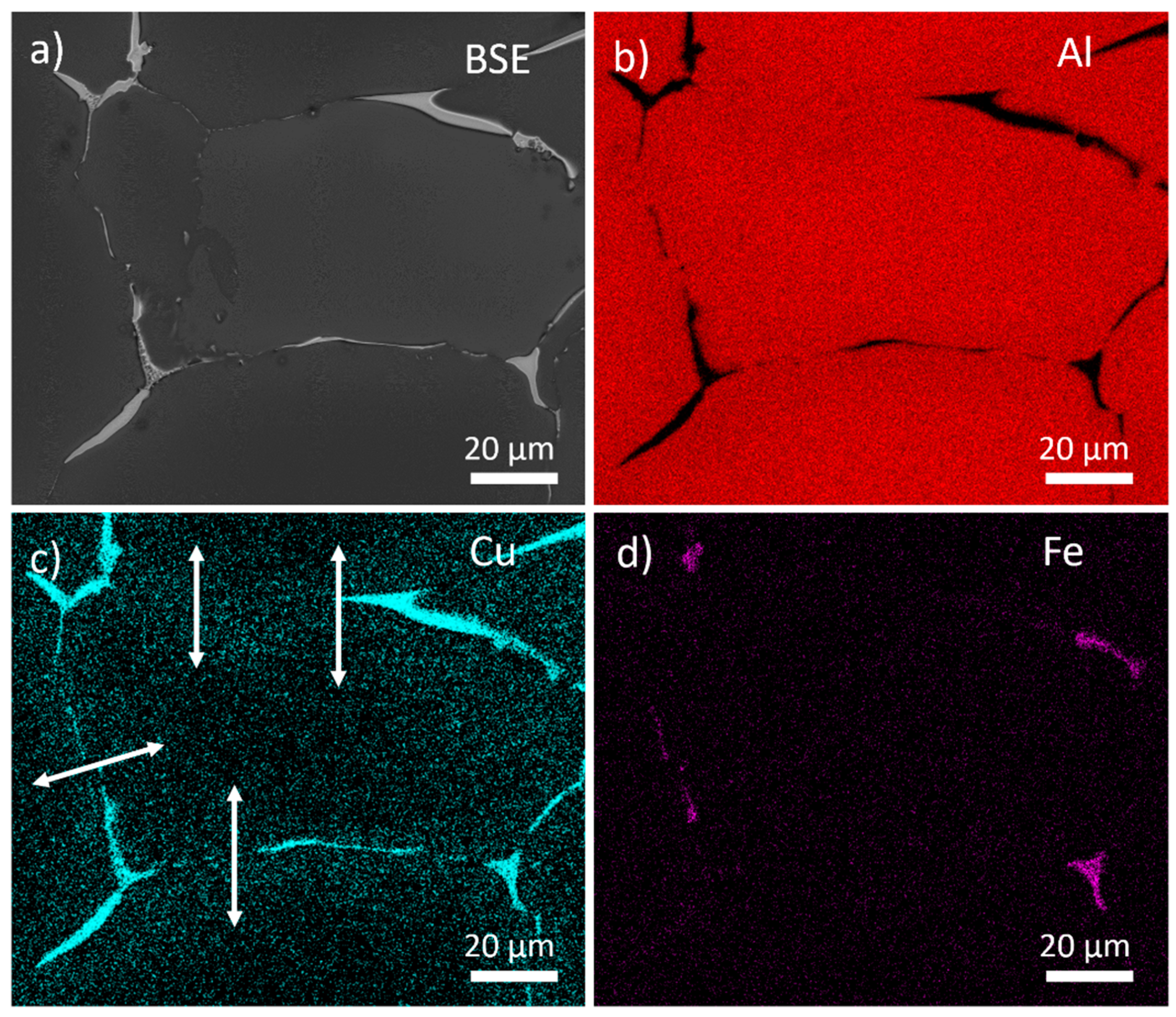
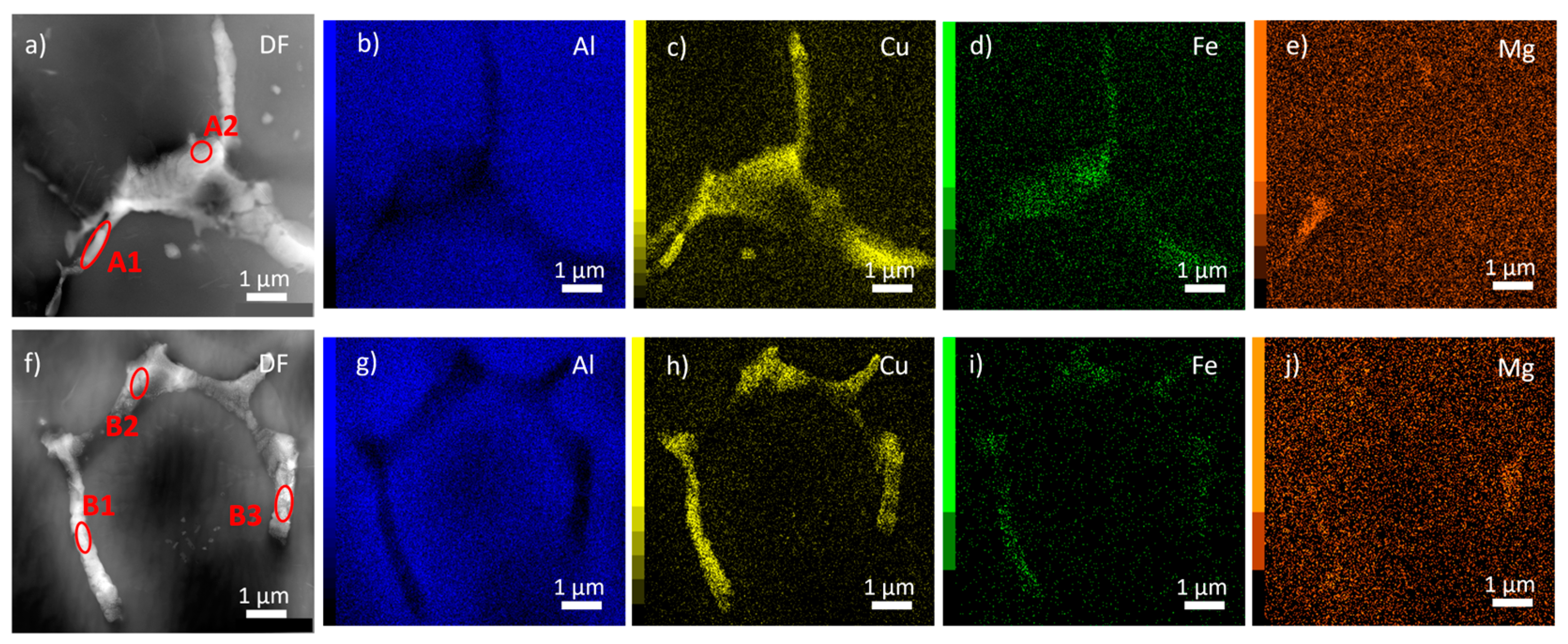
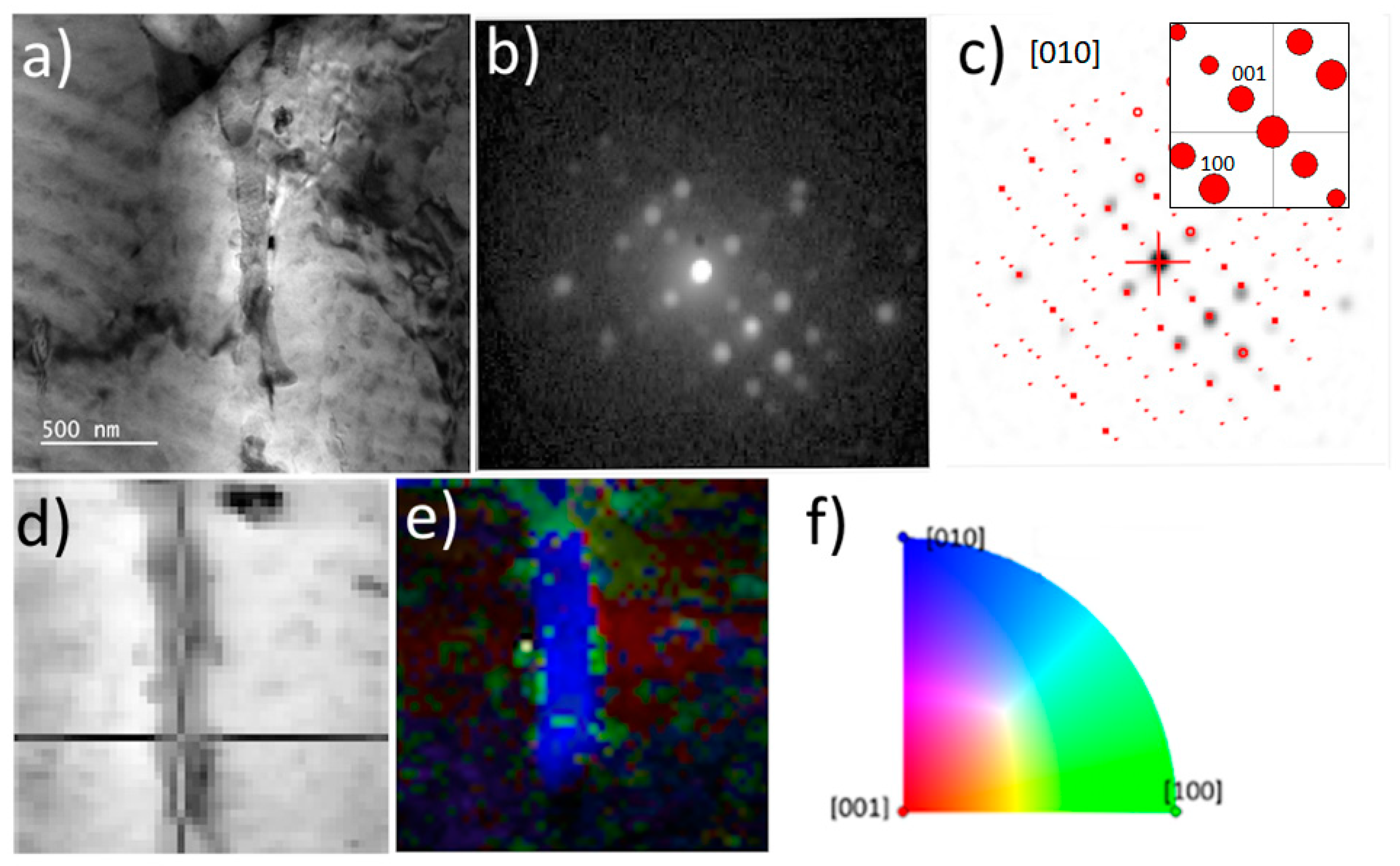




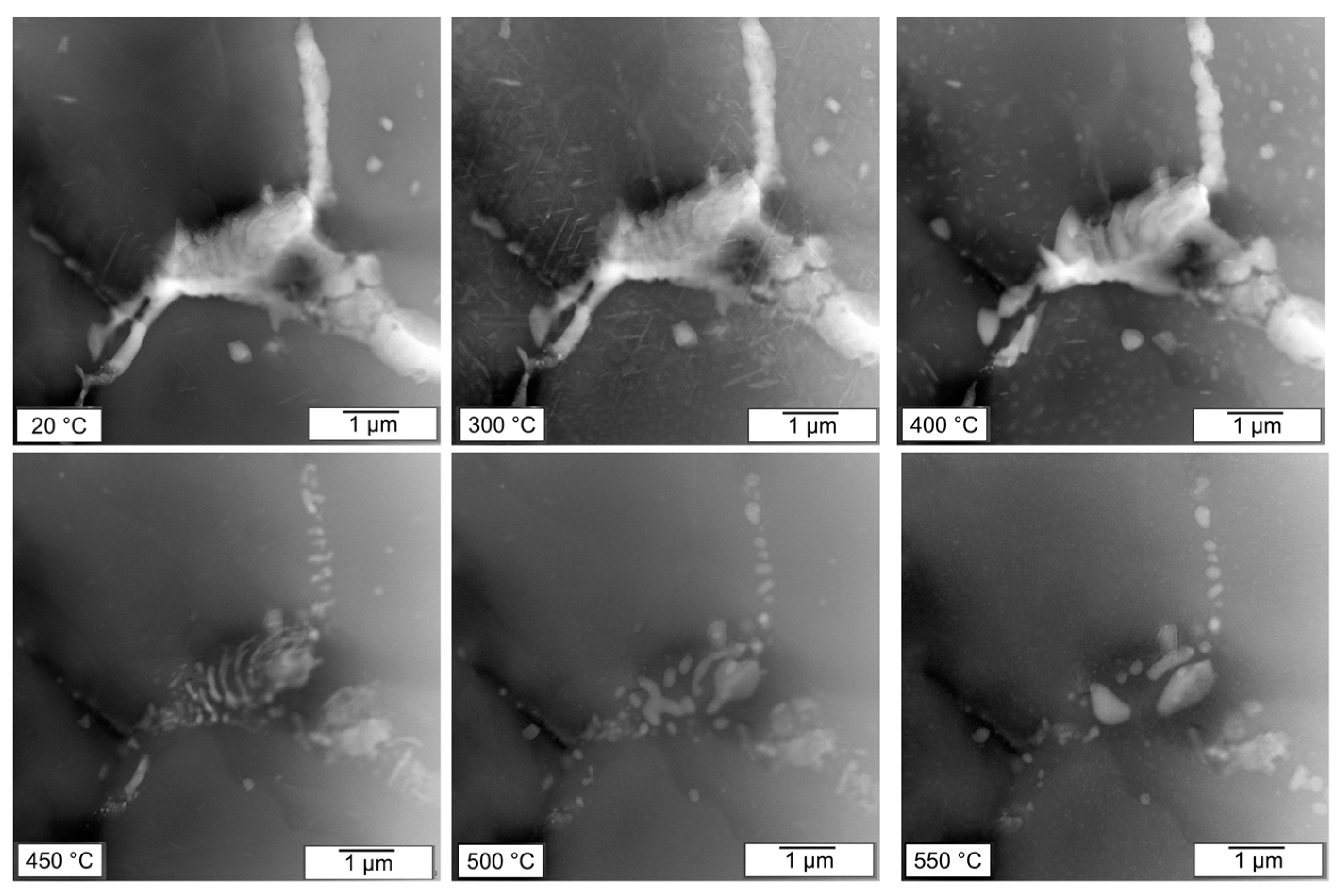
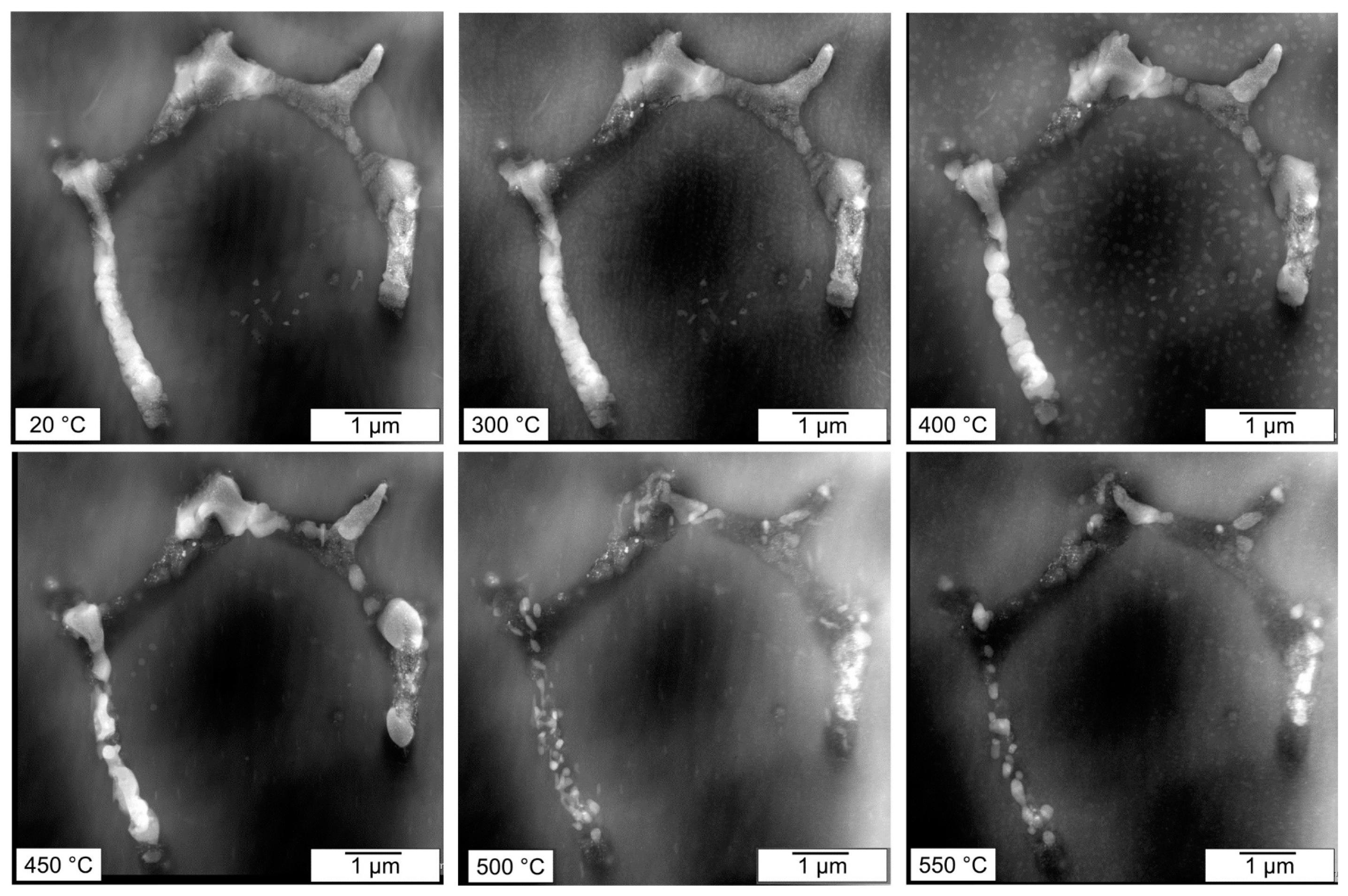
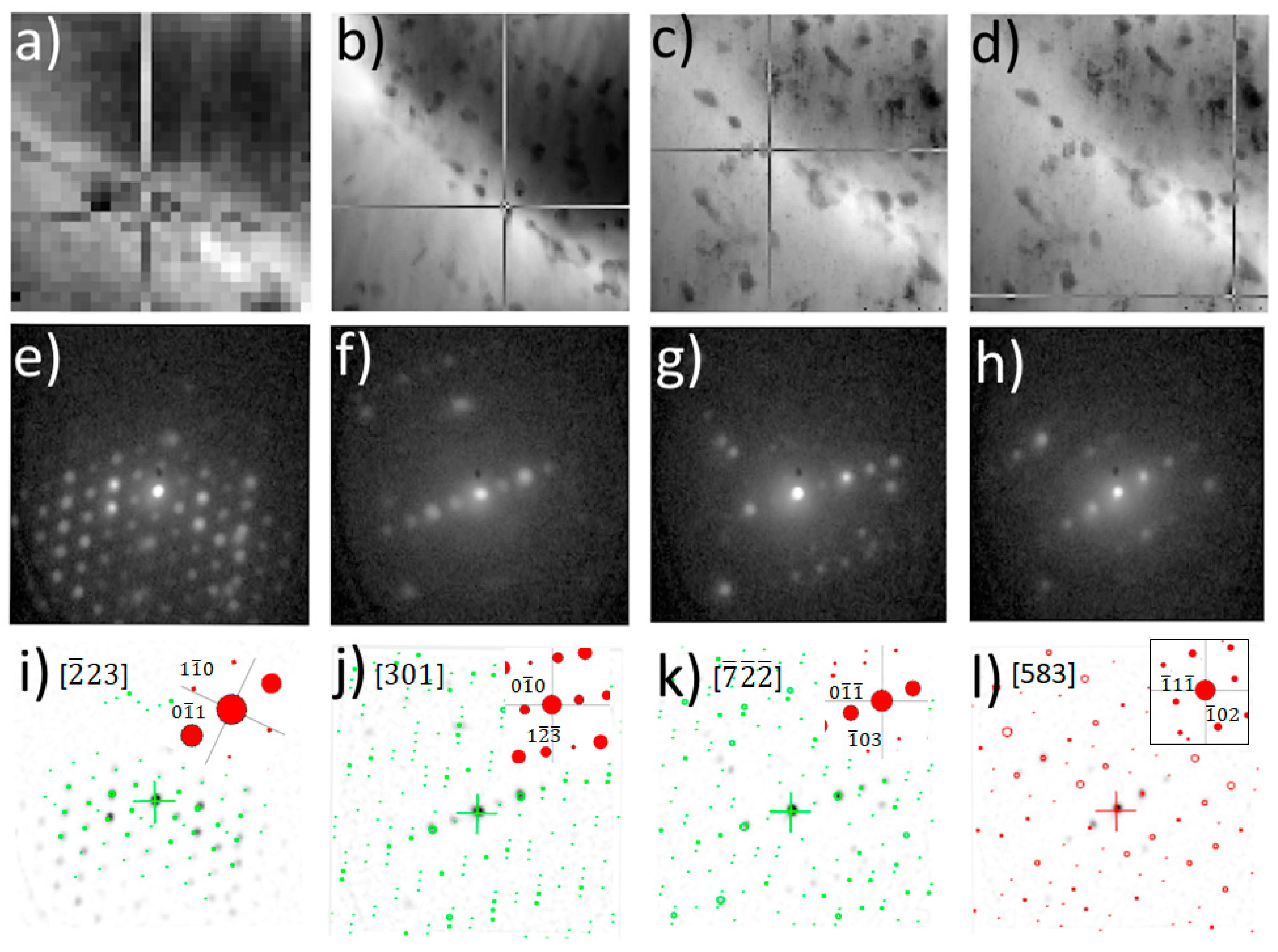

| Element | Cu | Li | Mg | Zr | Sc | Ag | Ti | V | Fe | Al |
|---|---|---|---|---|---|---|---|---|---|---|
| Concentration | 2.60(8) | 0.71(8) | 0.27(2) | 0.12(6) | 0.16(4) | 0.24(7) | 0.01(1) | 0.01(1) | 0.10(6) | bal. |
| Area | Al | Cu | Fe | Mg |
|---|---|---|---|---|
| A1 | 75.4 | 23.4 | 0.1 | 1.2 |
| A2 | 74.6 | 23.9 | 1.0 | 0.6 |
| B1 | 47.2 | 51.1 | 1.3 | 0.4 |
| B2 | 63.6 | 35.5 | 0.6 | 0.3 |
| B3 | 56.9 | 35.9 | 1.4 | 5.8 |
| Area | Al | Cu | Fe | Mg |
|---|---|---|---|---|
| C1 | 88.8 | 9.7 | 1.1 | 0.5 |
| C2 | 90.4 | 6.8 | 1.8 | 1.0 |
| D1 | 46.9 | 51.2 | 0.9 | 1.0 |
| D2 | 75.8 | 19.7 | 2.8 | 1.8 |
| D3 | 72.4 | 20.4 | 1.0 | 6.2 |
Disclaimer/Publisher’s Note: The statements, opinions and data contained in all publications are solely those of the individual author(s) and contributor(s) and not of MDPI and/or the editor(s). MDPI and/or the editor(s) disclaim responsibility for any injury to people or property resulting from any ideas, methods, instructions or products referred to in the content. |
© 2024 by the authors. Licensee MDPI, Basel, Switzerland. This article is an open access article distributed under the terms and conditions of the Creative Commons Attribution (CC BY) license (https://creativecommons.org/licenses/by/4.0/).
Share and Cite
Králík, R.; Bajtošová, L.; Kihoulou, B.; Preisler, D.; Cieslar, M. High-Temperature Phase Transformations in Al-Li-Cu-Mg-Zr-Sc Alloy Studied via In Situ Electron Microscopy. Crystals 2024, 14, 136. https://doi.org/10.3390/cryst14020136
Králík R, Bajtošová L, Kihoulou B, Preisler D, Cieslar M. High-Temperature Phase Transformations in Al-Li-Cu-Mg-Zr-Sc Alloy Studied via In Situ Electron Microscopy. Crystals. 2024; 14(2):136. https://doi.org/10.3390/cryst14020136
Chicago/Turabian StyleKrálík, Rostislav, Lucia Bajtošová, Barbora Kihoulou, Dalibor Preisler, and Miroslav Cieslar. 2024. "High-Temperature Phase Transformations in Al-Li-Cu-Mg-Zr-Sc Alloy Studied via In Situ Electron Microscopy" Crystals 14, no. 2: 136. https://doi.org/10.3390/cryst14020136
APA StyleKrálík, R., Bajtošová, L., Kihoulou, B., Preisler, D., & Cieslar, M. (2024). High-Temperature Phase Transformations in Al-Li-Cu-Mg-Zr-Sc Alloy Studied via In Situ Electron Microscopy. Crystals, 14(2), 136. https://doi.org/10.3390/cryst14020136







